Jacksonville, Fl. — The “Buresh Bottom Line”: Always be prepared!.....First Alert Hurricane Preparation Guide... City of Jacksonville Preparedness Guide... Georgia Hurricane Guide.
STAY INFORMED: Get the * FREE * First Alert Weather app
FREE NEWS UPDATES, ALERTS: Action News Jax app for Apple | For Android
WATCH “Preparing for the Storm”
WATCH “The Ins & Outs of Hurricane Season”
READ the First Alert Hurricane Center “Survival Guide”
LISTEN & WATCH “Surviving the Storm” - WOKV Radio & Action News Jax
***** ALWAYS CHECK & RE-CHECK THE LATEST FORECAST & UPDATES! *****
REMEMBER WHEN A TROPICAL STORM OR HURRICANE IS APPROACHING: Taping windows is *not* recommended & will not keep glass from breaking. Instead close curtains & blinds.
Realize the forecast cone (”cone of uncertainty”) is the average forecast error over a given time - out to 5 days - & *does not* indicate the width of the storm &/or where damage that might occur.
Eastern Atlantic... It’s no surprise for this time of year, but a few tropical waves have emerged off the West Coast of Africa. They have convection with them. However, It should run into some drier air as it tries to lift north of the “intertropical convergent zone,” or ITCZ. That doesn’t mean these features can’t develop as they get farther west over the next 7-10 days. This is the time of year that we have to watch each wave as it moves across the Atlantic. Just because the conditions are not conducive for development where the tropical wave is now, doesn’t mean they won’t be conducive where it is heading. We’ll keep an eye on it, at the very least.
Colorado State University and Dr. Phil Klotzbach released their final 2023 Atlantic hurricane seasonal outlook this week. They are still “calling” for an above-average season, despite a robust El Niño. Sea surface temperatures across the tropical Atlantic remain well above average. Typically, El Niño helps to reduce Atlantic hurricane activity due to an increase in vertical wind shear. We will see how that plays out through the peak of the hurricane season. You can read the full report here.






Water vapor loop (dark blue/yellow is dry mid & upper level air):


July tropical cyclone origins:
Averages below based on climatology for the Atlantic Basin for August:

Wind shear:




Saharan dust spreads west each year from Africa by the prevailing winds (from east to west over the Atlantic). Dry air - yellow/orange/red/pink. Widespread dust is indicative of dry air that can impede the development of tropical cyclones. However, sometimes “wanna’ be” waves will just wait until they get to the other side of - or away from - the plume then try to develop if other conditions are favorable. In my personal opinion, way too much is made about the presence of Saharan dust & how it relates to tropical cyclones. In any case, the peak of Saharan dust typically is in June & July.

2023 names..... “Emily” is the next name on the Atlantic list (names are picked at random by the World Meteorological Organization... repeat every 6 years). Historic storms are retired [Florence & Michael in ’18... Dorian in ’19 & Laura, Eta & Iota in ‘20, Ida in ‘21 & Fiona & Ian in ‘22]). In fact, this year’s list of names is rather infamous with “Katrina”, “Rita” & “Wilma” retired from the ‘05 list & “Harvey”, “Irma”,“Maria” & “Nate” from the ‘17 list. The WMO decided - beginning in 2021 - that the Greek alphabet will be no longer used & instead there will be a supplemental list of names if the first list is exhausted (has only happened three times - 2005, 2020 & 2021). The naming of tropical cyclones began on a consistent basis in 1953. More on the history of naming tropical cyclones * here *.





East Atlantic:





Mid & upper level wind shear (enemy of tropical cyclones) analysis (CIMMS). The red lines indicate strong shear:
Water vapor imagery (dark blue indicates dry air):

Deep oceanic heat content over the Gulf, Caribbean & deep tropical Atlantic. The brighter colors will expand rather dramatically by Aug./Sept./Oct.:

Sea surface temp. anomalies:


SE U.S. surface map:

Surface analysis centered on the tropical Atlantic:

Surface analysis of the Gulf:

Caribbean:

GFS wave forecast at 48 & 72 hours (2 & 3 days):


Atlantic Basin wave period forecast for 24, 48 & 72 hours respectively:



East/Central Pacific:




West Pacific:

Global tropical activity:
“Doksuri” is near the extreme Northern Philippines & will make a China landfall by late week:




Cox Media Group
:quality(70)/cloudfront-us-east-1.images.arcpublishing.com/cmg/KSK2GJATWZDXFCRSQK22CE442U.png)



:quality(70)/cloudfront-us-east-1.images.arcpublishing.com/cmg/YNYHQR4LBVFI3OJGCFF32OEDVM.png)
:quality(70)/cloudfront-us-east-1.images.arcpublishing.com/cmg/GYYIXKI5PNDDFJZQE5SOKCLQHE.jpg)
:quality(70)/cloudfront-us-east-1.images.arcpublishing.com/cmg/TIA4QAE7MNGFJD2GWC6S5VMB7M.jpg)
:quality(70)/cloudfront-us-east-1.images.arcpublishing.com/cmg/AD66IT3DXJFRLMNHO4BV6J4ENI.jpg)
:quality(70)/cloudfront-us-east-1.images.arcpublishing.com/cmg/V7XV6IDF4NCULCKWJ3RCUUFPHU.bmp)